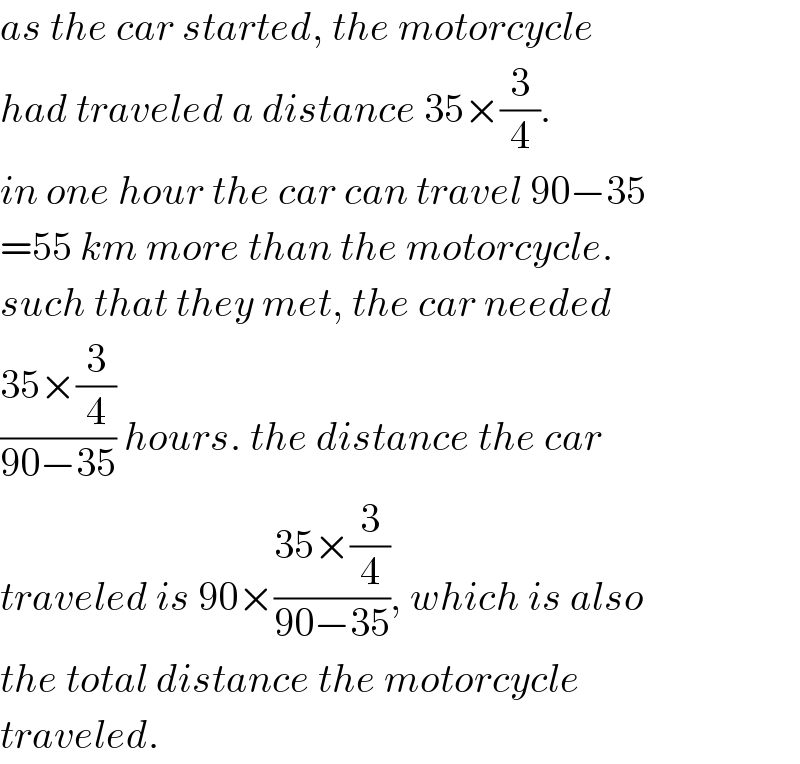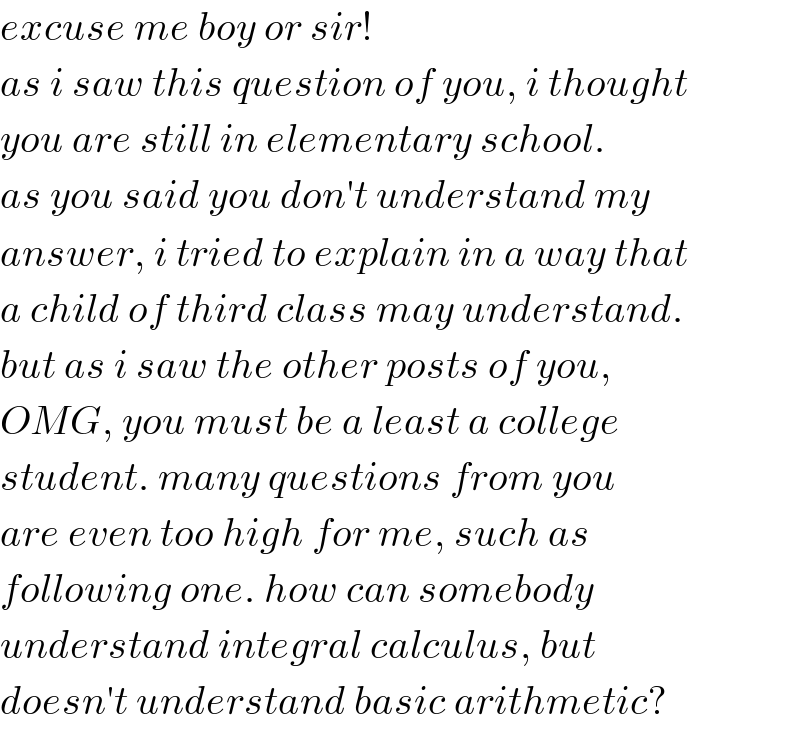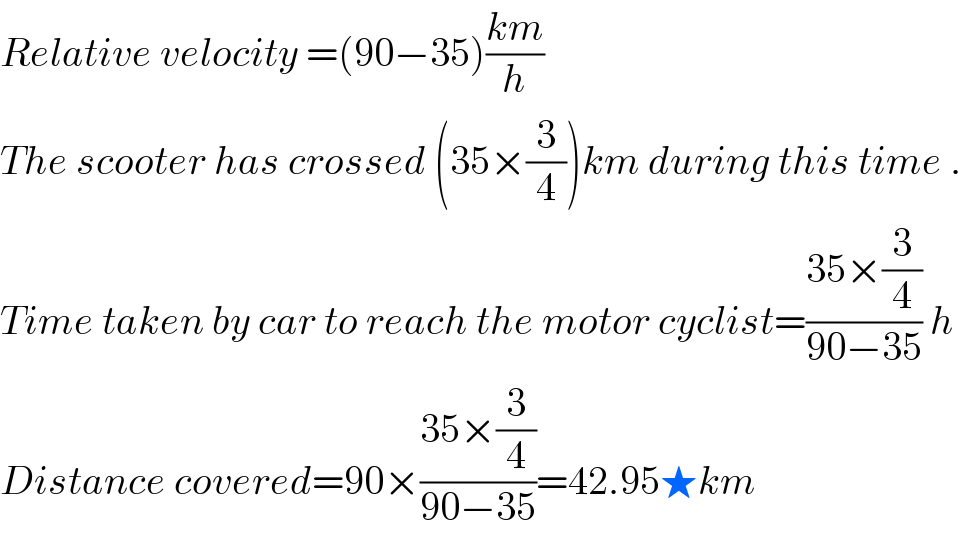
Question Number 101616 by 175 last updated on 03/Jul/20

Commented by Tinku Tara last updated on 03/Jul/20

$$\mathrm{Please}\:\mathrm{post}\:\mathrm{question}\:\mathrm{where}\:\mathrm{you} \\ $$$$\mathrm{yourself}\:\mathrm{doubt}. \\ $$
Answered by mr W last updated on 03/Jul/20

$$\mathrm{90}×\frac{\mathrm{35}×\frac{\mathrm{3}}{\mathrm{4}}}{\mathrm{90}−\mathrm{35}}=\mathrm{42}.\mathrm{95}\:{km} \\ $$
Commented by 175 last updated on 03/Jul/20
how? Explain
Commented by mr W last updated on 03/Jul/20

$${as}\:{the}\:{car}\:{started},\:{the}\:{motorcycle} \\ $$$${had}\:{traveled}\:{a}\:{distance}\:\mathrm{35}×\frac{\mathrm{3}}{\mathrm{4}}. \\ $$$${in}\:{one}\:{hour}\:{the}\:{car}\:{can}\:{travel}\:\mathrm{90}−\mathrm{35} \\ $$$$=\mathrm{55}\:{km}\:{more}\:{than}\:{the}\:{motorcycle}. \\ $$$${such}\:{that}\:{they}\:{met},\:{the}\:{car}\:{needed} \\ $$$$\frac{\mathrm{35}×\frac{\mathrm{3}}{\mathrm{4}}}{\mathrm{90}−\mathrm{35}}\:{hours}.\:{the}\:{distance}\:{the}\:{car} \\ $$$${traveled}\:{is}\:\mathrm{90}×\frac{\mathrm{35}×\frac{\mathrm{3}}{\mathrm{4}}}{\mathrm{90}−\mathrm{35}},\:{which}\:{is}\:{also} \\ $$$${the}\:{total}\:{distance}\:{the}\:{motorcycle} \\ $$$${traveled}. \\ $$
Commented by mr W last updated on 03/Jul/20

$${excuse}\:{me}\:{boy}\:{or}\:{sir}! \\ $$$${as}\:{i}\:{saw}\:{this}\:{question}\:{of}\:{you},\:{i}\:{thought} \\ $$$${you}\:{are}\:{still}\:{in}\:{elementary}\:{school}. \\ $$$${as}\:{you}\:{said}\:{you}\:{don}'{t}\:{understand}\:{my} \\ $$$${answer},\:{i}\:{tried}\:{to}\:{explain}\:{in}\:{a}\:{way}\:{that} \\ $$$${a}\:{child}\:{of}\:{third}\:{class}\:{may}\:{understand}. \\ $$$${but}\:{as}\:{i}\:{saw}\:{the}\:{other}\:{posts}\:{of}\:{you}, \\ $$$${OMG},\:{you}\:{must}\:{be}\:{a}\:{least}\:{a}\:{college} \\ $$$${student}.\:{many}\:{questions}\:{from}\:{you} \\ $$$${are}\:{even}\:{too}\:{high}\:{for}\:{me},\:{such}\:{as} \\ $$$${following}\:{one}.\:{how}\:{can}\:{somebody} \\ $$$${understand}\:{integral}\:{calculus},\:{but} \\ $$$${doesn}'{t}\:{understand}\:{basic}\:{arithmetic}? \\ $$
Commented by mr W last updated on 03/Jul/20

Commented by mr W last updated on 03/Jul/20

$${to}\:{be}\:{honest},\:{i}\:{was}\:\:{displeased}\:{as}\:{i} \\ $$$${realised}\:{this}. \\ $$
Commented by Tinku Tara last updated on 03/Jul/20

$$\mathrm{Also}\:\mathrm{same}\:\mathrm{as}\:\mathrm{in}\:\mathrm{q101329}. \\ $$
Answered by Dwaipayan Shikari last updated on 03/Jul/20

$${Relative}\:{velocity}\:=\left(\mathrm{90}−\mathrm{35}\right)\frac{{km}}{{h}} \\ $$$${The}\:{scooter}\:{has}\:{crossed}\:\left(\mathrm{35}×\frac{\mathrm{3}}{\mathrm{4}}\right){km}\:{during}\:{this}\:{time}\:. \\ $$$${Time}\:{taken}\:{by}\:{car}\:{to}\:{reach}\:{the}\:{motor}\:{cyclist}=\frac{\mathrm{35}×\frac{\mathrm{3}}{\mathrm{4}}}{\mathrm{90}−\mathrm{35}}\:{h} \\ $$$${Distance}\:{covered}=\mathrm{90}×\frac{\mathrm{35}×\frac{\mathrm{3}}{\mathrm{4}}}{\mathrm{90}−\mathrm{35}}=\mathrm{42}.\mathrm{95}\bigstar{km} \\ $$
